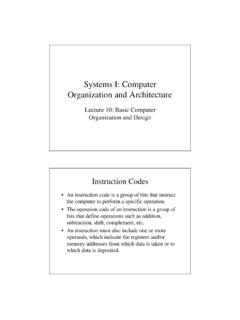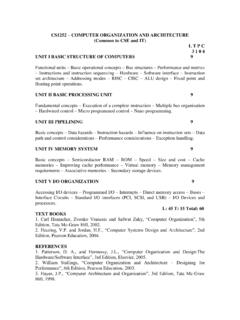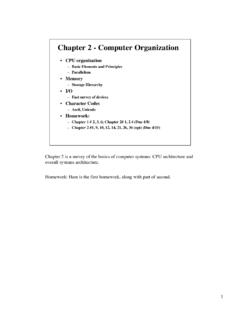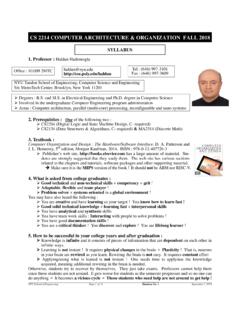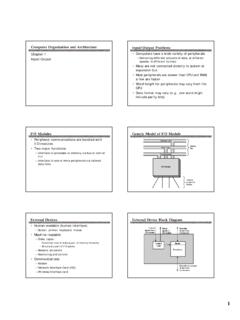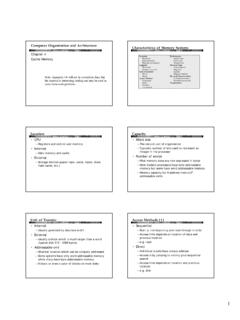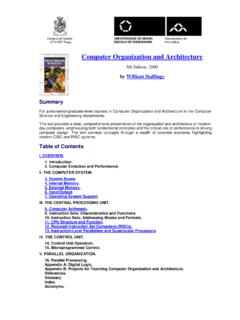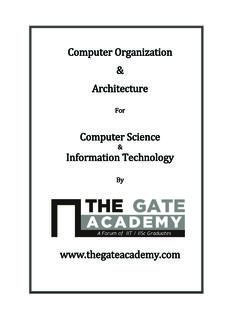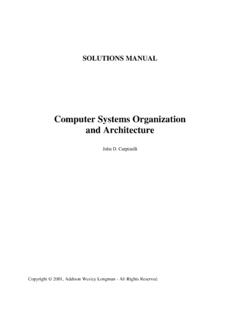Transcription of Assignments on Computer Organization and …
1 Page 1 of 6 Revised and updated: 14 Mar 2008 Assignments on Computer Organization and architecture CS-350: Computer Organization 2004 Charles Abzug Textbooks: (1a) NULL, LINDA; & LOBUR, JULIA (2006a). The Essentials of Computer Organization and architecture . Second Edition. Sudbury, MA: Jones & Bartlett Publishers, Inc. N85 2006; 2 dc22; 2005032106; ISBN 0-7637-3769-0. (1b) NULL, LINDA; & LOBUR, JULIA (2006b). An Introduction to Intel Assembly Language. Sudbury, MA: Jones & Bartlett Publishers, Inc. ISBN 0-7637-3585-X. (2) MAXFIELD, CLIVE RICHARD (2002). Bebop to the Boolean Boogie. An Unconventional Guide to Electronics Fundamentals, Second Edition. Boston, MA: Newnes (Elsevier). M323 2003; 5 dc20; 2002038930; ISBN 0750675438. NOTE on Your Reading Assignments : You would be well-advised, as you do your reading for the course, to make up a glossary of new and unfamiliar technical terms that you encounter.
2 This glossary can serve as an aid to you subsequently, when you are studying or reviewing the course material. Similarly, maintain a list of acronyms, and whenever you encounter a new and unfamiliar one, add it to your list along with the definition of what it stands for. You will be responsible for knowing the correct meaning of all technical terms and of all acronyms that appear anywhere in your assigned readings. assignment 1: Introduction, and Representation of Data in Computer Systems: READING: 1. Null and Lobur s (2006a) Preface: To the Student. Pages v vii. 2. Null and Lobur s (2006a) Chapter 1: Introduction. Pages 1-37, including Review of Essential Terms and Concepts on pp. 36-37. assignment 1 continues on the next page. CS-350 Assignments : Computer Organization AND architecture Page 2 of 6 Revised and updated: 14 Mar 2008 2008 Charles Abzug DELIVERABLE: Exercises 2, 3, 7, 13, and 14 on pages 37-38. assignment 2: READING: 3.
3 Null and Lobur s (2006a) Chapter 2, Data Representation in Computer System,. sections through (pages 39-63). Skip page 48 and the top of page 49, through example on page 51. 4. Maxfield s Chapter 7, Alternative Numbering Systems, pages 52-66. 5. Tutorial on the Representation of Numbers in Digital Computers, and on Digital Integer Arithmetic, pages 1-13. REVIEW & STUDY: Review Questions on Digital Number Representation (access the document from the course web page), particularly questions 5, 10, and 11. Try answering each of these questions by yourself, without looking at the answers that appear later in the document. Afterwards, check in the second part of the document to see if your answers are correct. DELIVERABLE: Null & Lobur s (2006a) Chapter 2: Exercises 5-9 and 11-12 on pages 94-95. Hand in your answers to these questions in hardcopy form on the due date for assignment 2. A good-faith effort to solve each of these problems is required for you to receive full credit for this assignment , regardless of whether your answers are right or wrong.
4 assignment 3: READING: 6. Null and Lobur s (2006a) Chapter 2, Data Representation in Computer System,. sections (pages 63-81). 7. Maxfield s Chapter 8: Binary Arithmetic, pages 67-79. 8. Tutorial on the Representation of Numbers in Digital Computers, and on Digital Integer Arithmetic, pages 14-end. DELIVERABLE: Null & Lobur s (2006a) Chapter 2: Exercises 19, 21a, 25-26, and 30 on pages 96-98. Hand in your answers to these questions in hardcopy form on the due date for assignment 3. A good-faith effort to solve each of these problems is required for you to receive full credit for this assignment , regardless of whether your answers are right or wrong. CS-350 Assignments : Computer Organization AND architecture Page 3 of 6 Revised and updated: 14 Mar 2008 2008 Charles Abzug assignment 4: Digital Logic Circuits, Part I : READING: 9. Null and Lobur s (2006a) Chapter 3: Boolean Algebra and Digital Logic,. Sections through (pages 109-131).
5 10. Maxfield s Chapter 1: Analog versus Digital; Chapter 2: Atoms, Molecules, and Crystals; Chapter 3: Conductors and Insulators; Voltage, Current, Resistance, Capacitance, and Inductance; and Chapter 4: semiconductors: Diodes and Transistors. Pages 1-35. REVIEW & STUDY: Null & Lobur s (2006a) Chapter 3: Review of Essential Terms and Concepts: #s 2-10. on pages 154-155. DELIVERABLE: Null & Lobur s (2006a) Chapter 3: Exercises 1-5, 7, 8a, 9a, 14 using truth tables, 18, and 19 on pages 155-157. assignment 5: Digital Logic Circuits, Part II: READING: 11. Null and Lobur s Chapter 3: Boolean Algebra and Digital Logic, Section (through only) and Section (pages 131-145 and 151-153). 12. Maxfield s Chapter 5: Primitive Logic Functions (pages 36-44); and Chapter 6: Using Transistors to Build Primitive Logic Functions (pages 45-51). REVIEW & STUDY: Null & Lobur s (2006a) Chapter 3: Review of Essential Terms and Concepts: #s 11-22 on page 155.
6 DELIVERABLE: Null & Lobur s (2006a) Chapter 3: Exercises 25, 32, 33, 36, 39, and 41 on pages 158-161. CS-350 Assignments : Computer Organization AND architecture Page 4 of 6 Revised and updated: 14 Mar 2008 2008 Charles Abzug assignment 6: Digital Logic Circuits, Part III: READING: 13. Maxfield s Chapter 9: Boolean Algebra (pages 80-96); Chapter 10: Karnaugh Maps (pages 97-104); Chapter 11: Using Primitive Logic Functions to Build More Complex Functions (pages 105-130) and Chapter 12: State Diagrams, State Tables, and State Machines (pages 131-139). Chapter 14: Integrated Circuits (ICs), REVIEW & STUDY: Review Questions on Binary Integer Arithmetic. Try answering each of these questions by yourself, without looking at the answers that appear later in the document. Afterwards, check in the second part of the document to see if your answers are correct. DELIVERABLE: Using the principles demonstrated in class, design two versions of the encoder for each of the seven segments of a digital numeric display: one based upon NAND-NAND, and the other based upon NOR-NOR.
7 You need to produce only one Truth Table for each of the seven display segments. However, you must write two Boolean equations, one in Sum of Products form and the other in the Product of Sums form. For each logical circuit, indicate the number of transistors in the circuit (do not include in your count the transistors in the NOT gates. You should, in summary, produce seven Truth Tables (one for each segment of the display), fourteen Boolean equations (two for each segment), fourteen logic diagrams (two for each segment), and fourteen transistor counts. Please note that there is no international standard on the labeling of the seven segments of the display. Please assign a lower-case letter to each segment, and be sure to include a diagram showing the seven segments with your labels, so that it will be apparent to the reader what you have done. assignment 7: Basic Computer Organization and architecture I: READING: 14.)
8 Null and Lobur s (2006a) Chapter 4: MARIE: An Introduction to a Simple Computer : Sections through (pages 177 through 203). 15. Maxfield s Chapter 14: Integrated Circuits (ICs), pages 143-161. REVIEW & STUDY: Null & Lobur s (2006a) Chapter 4: Review of Essential Terms and Concepts: #s 1through 25 (pages 236-237). DELIVERABLE: None. CS-350 Assignments : Computer Organization AND architecture Page 5 of 6 Revised and updated: 14 Mar 2008 2008 Charles Abzug assignment 8: Basic Computer Organization and architecture II: READING: 16. Null and Lobur s (2006a) Chapter 4: MARIE: An Introduction to a Simple Computer , Sections through (pages 203-234.). REVIEW & STUDY: Null & Lobur s (2006a) Chapter 4: Review of Essential Terms and Concepts: #s 26-41. on pages 236-237. DELIVERABLE: None. assignment 9: Instruction-Set architecture : READING: 17. Null and Lobur s (2006a) Chapter 5: A Closer Look at Instruction Set Architectures, (pages 243-273).
9 REVIEW & STUDY: Null & Lobur s (2006a) Chapter 5: Review of Essential Terms and Concepts: pages 274-275. DELIVERABLE: Null & Lobur s (2006a) Chapter 4: Exercises 3-10, 12, 13, and 29 on pages 237-241, and also answer the eight True/False questions on page 241. assignment 10: REQUIRED READINGS: 18. Maxfield s Chapter 15: Memory ICs, pages 162-177; Chapter 16: Programmable ICs, pages 178-200, and Chapter 17: Application-Specific Integrated Circuits, pages 201-220. REVIEW & STUDY: Maxfield s Summary for Chapter 17 (pages 219-220). CS-350 Assignments : Computer Organization AND architecture Page 6 of 6 Revised and updated: 14 Mar 2008 2008 Charles Abzug DELIVERABLE: Null & Lobur s (2006a) Chapter 5: Exercises 1, 2, 3, 5, 6, and 13-16 on pages 275-279.




